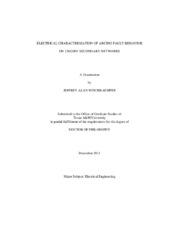| dc.description.abstract | Arcing faults have been a persistent problem on power systems for over one hundred years, damaging equipment and creating safety hazards for both utility personnel and the public. On low-voltage secondary networks, arcing faults are known to cause specific hazards collectively called "manhole events", which include smoke and fire in underground structures, and in extreme cases explosions. This research provides the first comprehensive attempt to electrically characterize naturally occurring arcing fault behavior on 120/208V secondary networks.
Research was performed in conjunction with the Consolidated Edison Company of New York, whereby a single low-voltage network was instrumented with thirty high-speed, high-fidelity data recording devices. For a nominal one year period, these devices collected detailed, high-speed waveform recordings of arcing faults and other system transients, as well as statistical power system data, offering new insights into the behavior of arcing faults on low-voltage networks.
Data obtained in this project have shown the intensity, persistence, and frequency of arcing faults on low-voltage networks to be much higher than commonly believed. Results indicate that arcing faults may persist on a more-or-less continuous basis for hours without self-extinguishing, may recur over a period of hours, days, or weeks without generating enough physical evidence to be reported by the public or operate conventional protective devices, and may draw enough current to be observed at the primary substation serving the network. Additionally, simultaneous fault current measurements recorded at multiple locations across the network suggest the possibility of using multi-point secondary monitoring to detect and locate arcing faults before they cause a manhole event. | en |


